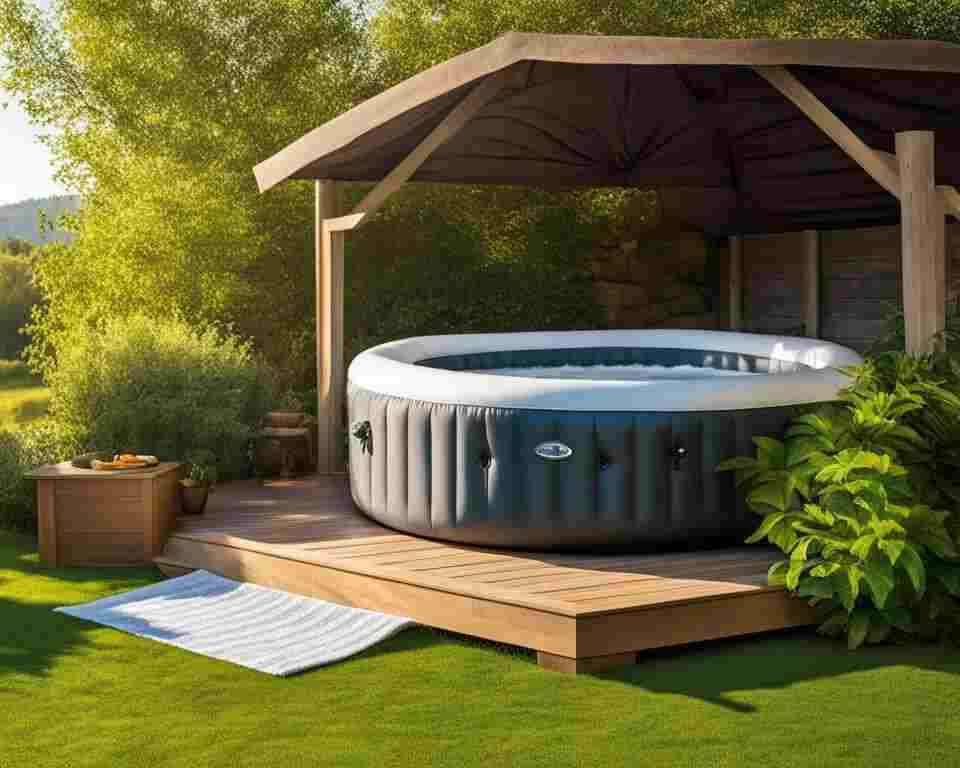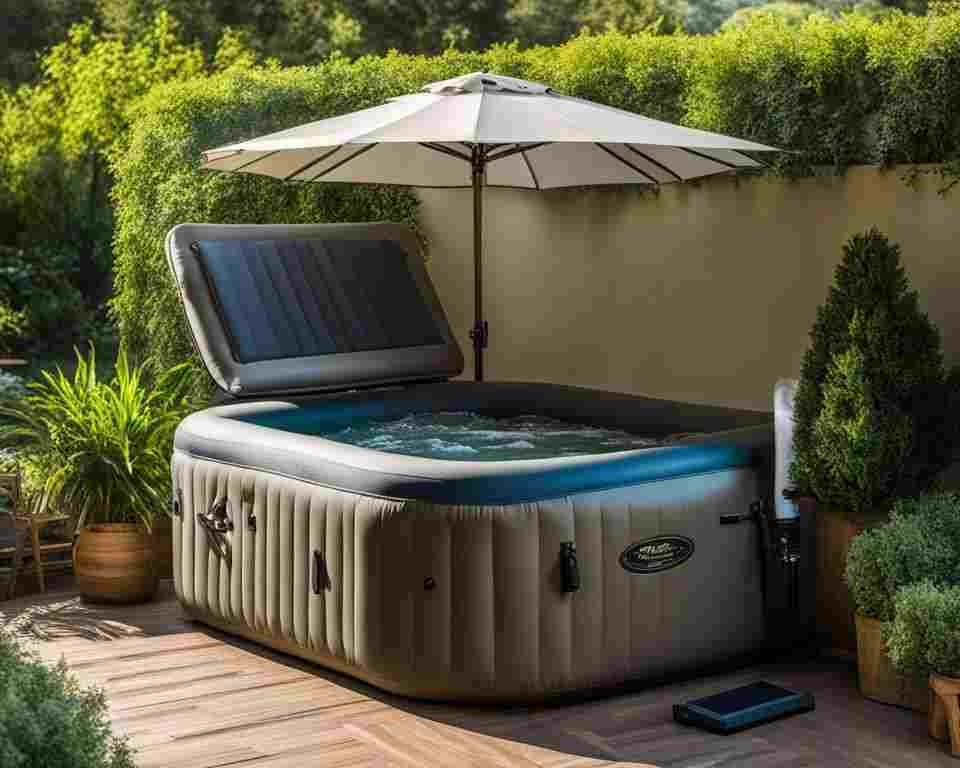Homeowners are increasingly opting for inflatable hot tubs due to their convenience, flexibility, and relaxation benefits. But are inflatable hot tubs energy efficient? In this article, we’ll explore whether inflatable hot tubs can help you save on energy consumption and be a cost-effective choice.
We’ll look into their unique features, such as energy-saving options and efficient heating designs, and discuss the factors that contribute to their energy efficiency. However, it’s essential to be aware of the challenges that come with owning an inflatable spa.
Key Takeaways:
- Inflatable hot tubs offer a portable and cost-effective option for enjoying a relaxing spa experience at home.
- Energy-efficient designs and materials can contribute to lower energy consumption in inflatable hot tubs.
- Maintaining the right water temperature and using energy-saving features can further enhance energy efficiency.
- Considering factors such as insulation, pump efficiency, and heating systems can help you choose an energy-efficient inflatable hot tub.
- Regular maintenance and optimizing heat retention through cover usage and ambient temperature control can increase energy efficiency.

Are Inflatable Hot Tubs Energy Efficient?
Yes, inflatable hot tubs can indeed be energy-efficient. Their design, insulation, and heating systems are specifically engineered to minimize energy consumption. Compared to traditional hot tubs, inflatable ones are designed with insulation that helps retain heat, ensuring maximum energy efficiency.
They often come with features like programmable timers and power-saving modes that further optimize energy usage. Overall, these energy-saving measures make inflatable hot tubs a cost-effective and environmentally friendly option for relaxation.
Understanding the Basics of Inflatable Hot Tubs
In this section, we will delve into the fundamental aspects of inflatable hot tubs, providing you with a comprehensive understanding of their design, functionality, and unique features.
What is an Inflatable Hot Tub and How Does it Work?
An inflatable hot tub is a portable and space-saving alternative to traditional hot tubs. Made from durable materials such as PVC or vinyl, these tubs can be inflated and filled with water, creating a soothing and relaxing spa experience.
But how does it work? The hot tub is equipped with a combination of key components that work together to provide a luxurious and rejuvenating bathing experience. Let’s explore these components in detail.
Key Components of Inflatable Hot Tubs: Pumps, Filters, and Heaters
Pumps: The heart of the inflatable hot tub, pumps circulate water, create the bubbling effect, and ensure proper filtration. These pumps are responsible for maintaining a steady flow of water and ensuring its cleanliness.
Filters: Filters play a crucial role in removing impurities from the water, ensuring a hygienic and safe environment for your hot tub experience. These filters trap debris, dirt, and other contaminants, keeping the water clean and clear.
Heaters: To achieve and maintain the desired temperature, inflatable hot tubs are equipped with heaters. These heaters efficiently warm the water to your preferred level, allowing you to enjoy a soothing soak.
The Portability Factor: Advantages and Challenges
One of the major advantages of inflatable hot tubs is their portability. These tubs can be easily deflated, making them highly convenient for transportation and storage. Whether you’re moving to a new home or simply rearranging your backyard, inflatable hot tubs offer flexibility and ease of use.
However, portability also presents some challenges. As these tubs are designed to be lightweight and portable, they may have less insulation compared to traditional hot tubs. This can result in faster heat loss and potentially higher energy consumption.
| Advantages | Challenges |
|---|---|
| 1. Portability and ease of transportation | 1. Faster heat loss due to less insulation |
| 2. Space-saving design | 2. Potentially higher energy consumption |
| 3. Flexibility in terms of placement and storage | |
| 4. Affordable option compared to traditional hot tubs |
Assessing Inflatable Hot Tub Energy Efficiency
In this section, I will look into the energy efficiency of inflatable hot tubs and explore whether they are a cost-effective and energy-saving option for homeowners. We will examine the factors that contribute to their energy consumption and discuss the advantages and challenges of using inflatable hot tubs.
When it comes to energy efficiency, inflatable hot tubs have come a long way. Manufacturers have incorporated various energy-saving features and designs to minimize their energy consumption without compromising on performance. These energy-efficient designs help to reduce the overall energy required for heating and maintaining the temperature of the water in the tub.
Efficient heating is crucial in inflatable tubs to ensure low energy consumption. Most inflatable hot tubs feature advanced heating systems that can quickly and effectively heat the water to the desired temperature. These heating systems are designed to be energy efficient, allowing you to enjoy a relaxing soak without worrying about high energy bills.
In addition to efficient heating, insulation is another essential factor in the energy efficiency of inflatable hot tubs. Insulation plays a crucial role in minimizing heat loss, ensuring that the water stays warm for longer periods. Many inflatable hot tubs incorporate high-quality insulation materials and designs to prevent heat from escaping, ultimately reducing energy consumption.
Furthermore, pump efficiency is critical in inflatable hot tubs’ energy consumption. The pump is responsible for circulating the water, maintaining filtration, and powering the jets. Energy-saving pumps are designed to operate efficiently while using minimal energy, contributing to overall energy efficiency.
Overall, inflatable hot tubs have made significant strides in energy efficiency, offering homeowners an energy-saving and cost-effective alternative to traditional hot tubs. By choosing an energy-efficient model with the right features and designs, you can enjoy the luxurious experience of a hot tub while minimizing your environmental impact and saving on energy costs.
Comparing Energy Consumption: Inflatable vs. Traditional Hot Tubs
When it comes to choosing a hot tub, energy consumption and efficiency are important factors to consider. In this section, we will compare the energy usage of inflatable hot tubs and traditional hot tubs to determine which option is more cost-effective and energy efficient.
To assess the energy consumption of both types of hot tubs, we will analyze their energy-saving features, insulation capabilities, and heating systems. By evaluating these factors, we can gain insights into how each type of hot tub minimizes energy waste and maximizes efficiency.
One key advantage of inflatable hot tubs is their low energy consumption. These portable spas are designed with energy-efficient materials and technology, allowing them to maintain warm water temperatures while using less power. Additionally, many inflatable hot tubs come equipped with efficient heating systems that heat up the water quickly and retain heat effectively.
To illustrate the differences in energy consumption between inflatable and traditional hot tubs, let’s take a look at the following comparison table:
| Inflatable Hot Tubs | Traditional Hot Tubs | |
|---|---|---|
| Energy Consumption | Low | High |
| Energy Efficiency | High | Variable |
| Cost-Effectiveness | High | Variable |
As the table shows, inflatable hot tubs generally have lower energy consumption and higher energy efficiency compared to traditional hot tubs. This not only helps save on energy costs but also makes inflatable hot tubs more environmentally friendly.
It’s worth noting that the actual energy consumption and efficiency may vary depending on specific models and brands of hot tubs. Therefore, it is recommended to compare the energy-saving features and specifications of different hot tub options before making a purchase decision.
Now that we have analyzed the energy consumption of inflatable and traditional hot tubs, let’s move on to the next section where we will discuss practical tips for implementing energy-saving practices with inflatable hot tubs.

Implementing Energy-Saving Practices for Inflatable Hot Tubs
When it comes to inflatable hot tubs, there are several practical tips and advice you can follow to ensure energy efficiency and save on costs. In this section, we will discuss how to find energy-efficient models, provide maintenance and care tips, and explore methods for optimizing heat retention through cover usage and ambient temperature considerations.
Finding Energy-Efficient Models: What to Look For
When purchasing an inflatable hot tub, it’s important to consider its energy-saving features and design elements. Look for models that offer:
- Insulation: Opt for tubs with high-quality insulation materials to minimize heat loss and maximize efficiency.
- Efficient Heating Systems: Choose hot tubs that have advanced heating systems to ensure quick and effective heat distribution.
- Pump Efficiency: Select models with energy-efficient pumps that consume less electricity while maintaining excellent performance.
By investing in an energy-efficient inflatable hot tub, you can enjoy all the benefits while minimizing energy consumption and reducing your carbon footprint.
Maintenance and Care: Tips to Increase Efficiency
- Regular Cleaning: Clean the filters and jets of your hot tub regularly to prevent clogging and ensure optimal water flow.
- Water Quality Maintenance: Maintain proper chemical balance in the water to prevent bacterial growth and reduce the strain on the filtration system.
- Monitor Temperature: Set the temperature of your hot tub according to your needs and avoid unnecessary heat-ups to save on energy consumption.
By following these maintenance practices, you can prolong the lifespan of your inflatable hot tub and improve its overall efficiency.
Optimizing Heat Retention: Cover Usage and Ambient Temperatures
To optimize heat retention in your inflatable hot tub, consider the following:
- Use of Cover: Always use the cover provided with your hot tub when not in use to prevent heat loss through evaporation and keep the water warm for longer periods.
- Ambient Temperatures: Position your hot tub in a sheltered area or consider using windbreakers to minimize the impact of external temperatures on heat loss.
Optimizing heat retention not only helps in reducing energy consumption but also allows for a more enjoyable and comfortable hot tub experience.

| Feature | Description |
|---|---|
| Insulation | High-quality insulation materials minimize heat loss and improve energy efficiency. |
| Efficient Heating Systems | Advanced heating systems ensure quick and effective heat distribution. |
| Pump Efficiency | Energy-efficient pumps consume less electricity while maintaining excellent performance. |
Conclusion
In conclusion, inflatable hot tubs offer a range of advantages in terms of energy efficiency, cost-effectiveness, and eco-friendliness. By accurately weighing the pros and cons, homeowners can make an informed decision about whether an inflatable hot tub is the right choice for them.
Accurately Weighing the Pros and Cons of Inflatable Hot Tubs
When considering the energy efficiency of inflatable hot tubs, it is important to evaluate their insulation, heating systems, and pump efficiency. While some models may have lower energy consumption due to their design and features, others may require more energy to maintain optimal water temperature.
On the plus side, inflatable hot tubs typically have a lower upfront cost compared to traditional hot tubs. Additionally, they are portable and easy to install, making them a convenient option for those who want to enjoy the benefits of a hot tub without the need for extensive construction or permanent fixtures.
However, it’s essential to weigh these advantages against the potential drawbacks. Inflatable hot tubs may have shorter lifespans compared to their traditional counterparts, and they require regular maintenance to ensure optimal performance. Additionally, some models may have limited seating capacity and features compared to larger, permanent hot tubs.
Long-Term Cost Implications of Inflatable Spa Ownership
When examining the long-term cost implications, it’s important to consider the maintenance and repairs that may be required over time. While inflatable hot tubs may have lower upfront costs, they may require more frequent maintenance and occasional replacements of components such as filters and heaters.
Furthermore, the energy consumption of an inflatable hot tub should be taken into account. While some models are designed with energy-saving features to minimize energy usage, others may have higher energy consumption. Homeowners should carefully evaluate their usage patterns and the associated energy costs to determine the long-term financial implications.
Recommendations for Eco-Friendly and Cost-Efficient Hot Tub Options
For those seeking eco-friendly and cost-efficient hot tub options, there are a few recommendations to consider. Firstly, look for inflatable hot tub models that are specifically designed and marketed as energy-efficient. These models often have advanced insulation, efficient heating systems, and energy-saving features.
Additionally, implementing energy-saving practices such as covering the hot tub when not in use and maintaining the water temperature at an optimal level can further reduce energy consumption and associated costs. Regular maintenance, including cleaning filters and checking for leaks, is also crucial to ensure the hot tub operates efficiently.
Ultimately, the decision to invest in an inflatable hot tub should be based on an evaluation of individual preferences, budget considerations, and long-term cost implications. By considering the pros and cons, understanding the energy efficiency factors at play, and implementing energy-saving practices, homeowners can make an informed choice that aligns with their lifestyle and goals.
FAQ
Are inflatable hot tubs energy efficient?
Yes, inflatable hot tubs can be energy efficient. Their energy efficiency depends on factors such as insulation, heating systems, and pump efficiency. Some inflatable hot tub models also offer energy-saving features and design elements.
What is an inflatable hot tub and how does it work?
An inflatable hot tub is a portable spa that can be easily inflated and deflated. It typically consists of a durable, puncture-resistant material and is equipped with a built-in pump, heater, and filtration system. The hot tub works by drawing in water from the surrounding environment, heating it, and circulating it through the jets to provide a relaxing and therapeutic experience.
What are the key components of inflatable hot tubs?
The key components of inflatable hot tubs include pumps, filters, and heaters. The pump is responsible for circulating the water, while the filter removes impurities. The heater maintains the desired temperature of the water, ensuring a warm and comfortable soak.
What are the advantages and challenges of owning a portable hot tub?
The main advantage of owning a portable hot tub is its portability. You can easily set it up and take it down, allowing you to enjoy a hot tub experience anywhere, anytime. However, portable hot tubs may have limited seating capacity and may require additional maintenance compared to permanent hot tub installations.
How does the energy consumption of inflatable hot tubs compare to traditional hot tubs?
Inflatable hot tubs generally have lower energy consumption compared to traditional hot tubs. Their smaller size and efficient heating systems contribute to this energy-saving advantage. However, it’s important to compare specific models and their energy ratings for a more accurate assessment.
How can I implement energy-saving practices with an inflatable hot tub?
To implement energy-saving practices with an inflatable hot tub, you can look for energy-efficient models that have features like programmable timers, insulation layers, and efficient heating systems. Regular maintenance and care, such as cleaning and replacing filters, can also help optimize energy efficiency. Additionally, using a cover when the hot tub is not in use and considering ambient temperatures can help retain heat and reduce energy consumption.
What are the long-term cost implications of owning an inflatable spa?
The long-term cost implications of owning an inflatable spa include electricity usage, water consumption, maintenance costs, and potential repair or replacement expenses. However, with proper energy-saving practices and maintenance, inflatable spas can be a cost-effective option compared to traditional hot tubs.
What are some eco-friendly and cost-efficient hot tub options?
Some eco-friendly and cost-efficient hot tub options include inflatable hot tubs with energy-saving features, such as efficient pumps and insulation. Additionally, eco-friendly hot tubs may have eco-friendly materials and energy-efficient designs. It’s important to research and compare different models to find the best fit for your needs and budget.

